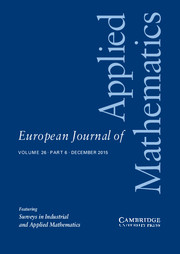Article contents
Expansions for the linear-elastic contribution to the self-interaction force of dislocation curves
Published online by Cambridge University Press: 20 October 2021
Abstract
The self-interaction force of dislocation curves in metals depends on the local arrangement of the atoms and on the non-local interaction between dislocation curve segments. While these non-local segment–segment interactions can be accurately described by linear elasticity when the segments are further apart than the atomic scale of size  $\varepsilon$, this model breaks down and blows up when the segments are
$\varepsilon$, this model breaks down and blows up when the segments are  $O(\varepsilon)$ apart. To separate the non-local interactions from the local contribution, various models depending on
$O(\varepsilon)$ apart. To separate the non-local interactions from the local contribution, various models depending on  $\varepsilon$ have been constructed to account for the non-local term. However, there are no quantitative comparisons available between these models. This paper makes such comparisons possible by expanding the self-interaction force in these models in
$\varepsilon$ have been constructed to account for the non-local term. However, there are no quantitative comparisons available between these models. This paper makes such comparisons possible by expanding the self-interaction force in these models in  $\varepsilon$ beyond the O(1)-term. Our derivation of these expansions relies on asymptotic analysis. The practical use of these expansions is demonstrated by developing numerical schemes for them, and by – for the first time – bounding the corresponding discretisation error.
$\varepsilon$ beyond the O(1)-term. Our derivation of these expansions relies on asymptotic analysis. The practical use of these expansions is demonstrated by developing numerical schemes for them, and by – for the first time – bounding the corresponding discretisation error.
Information
- Type
- Papers
- Information
- Copyright
- © The Author(s), 2021. Published by Cambridge University Press
References
- 1
- Cited by


